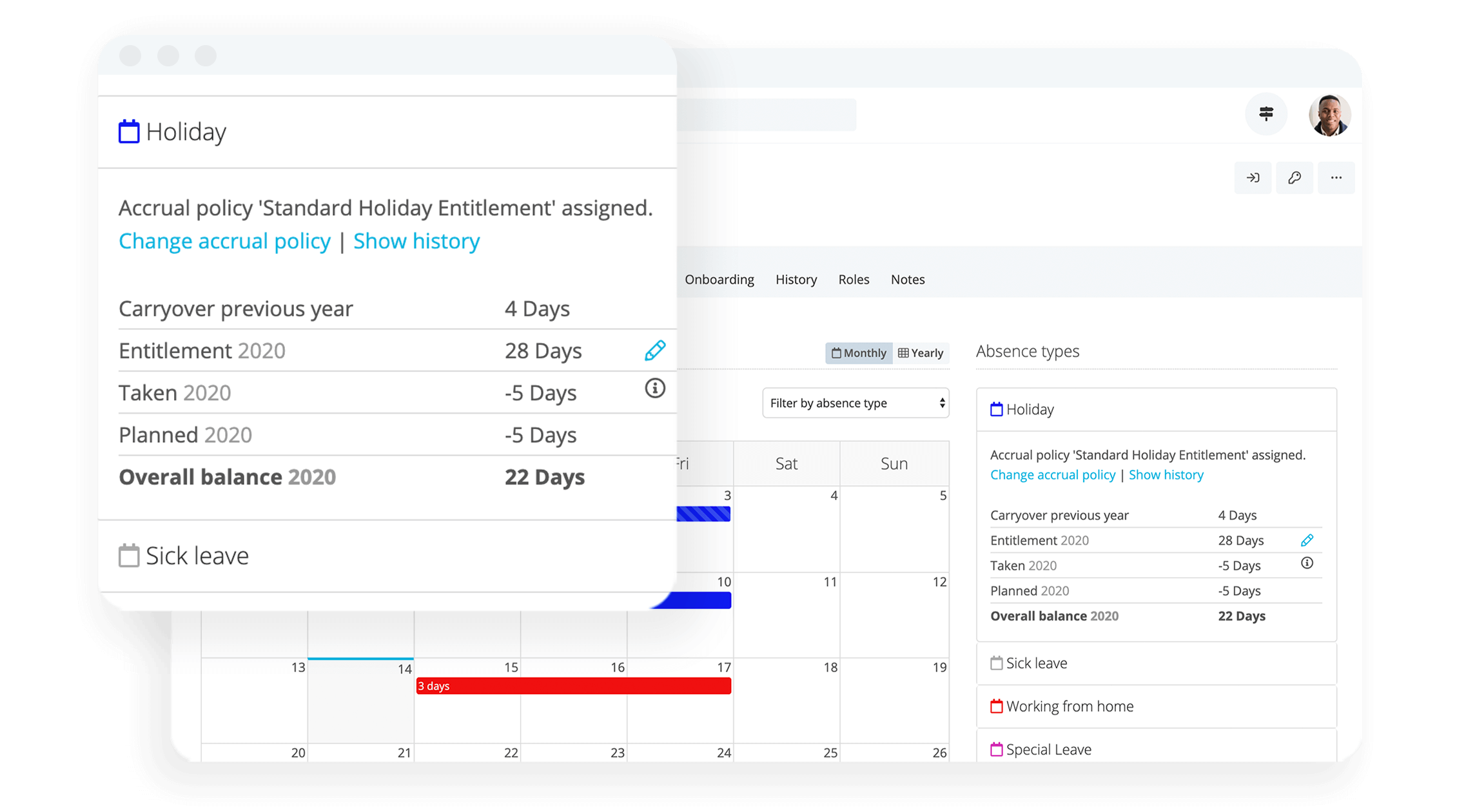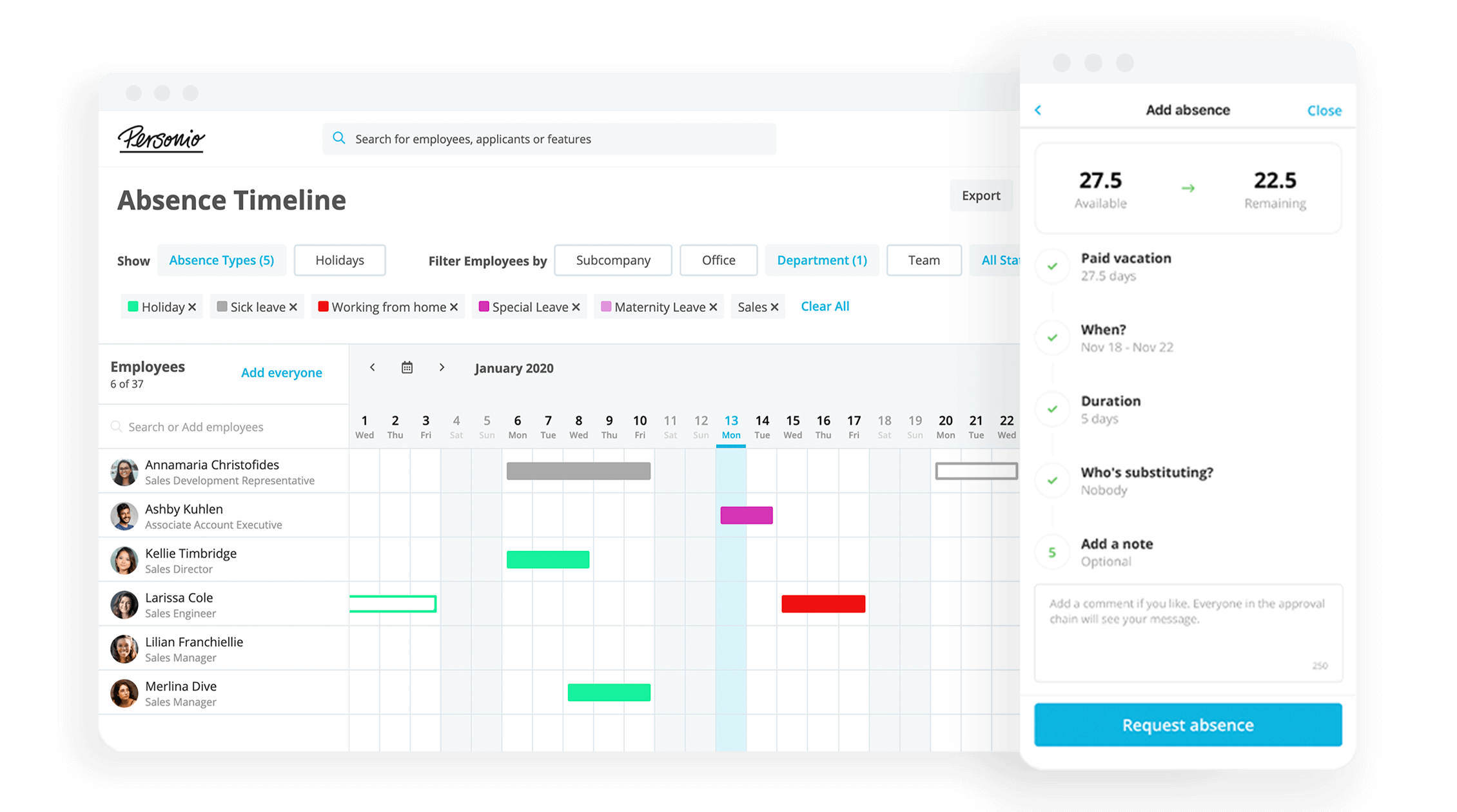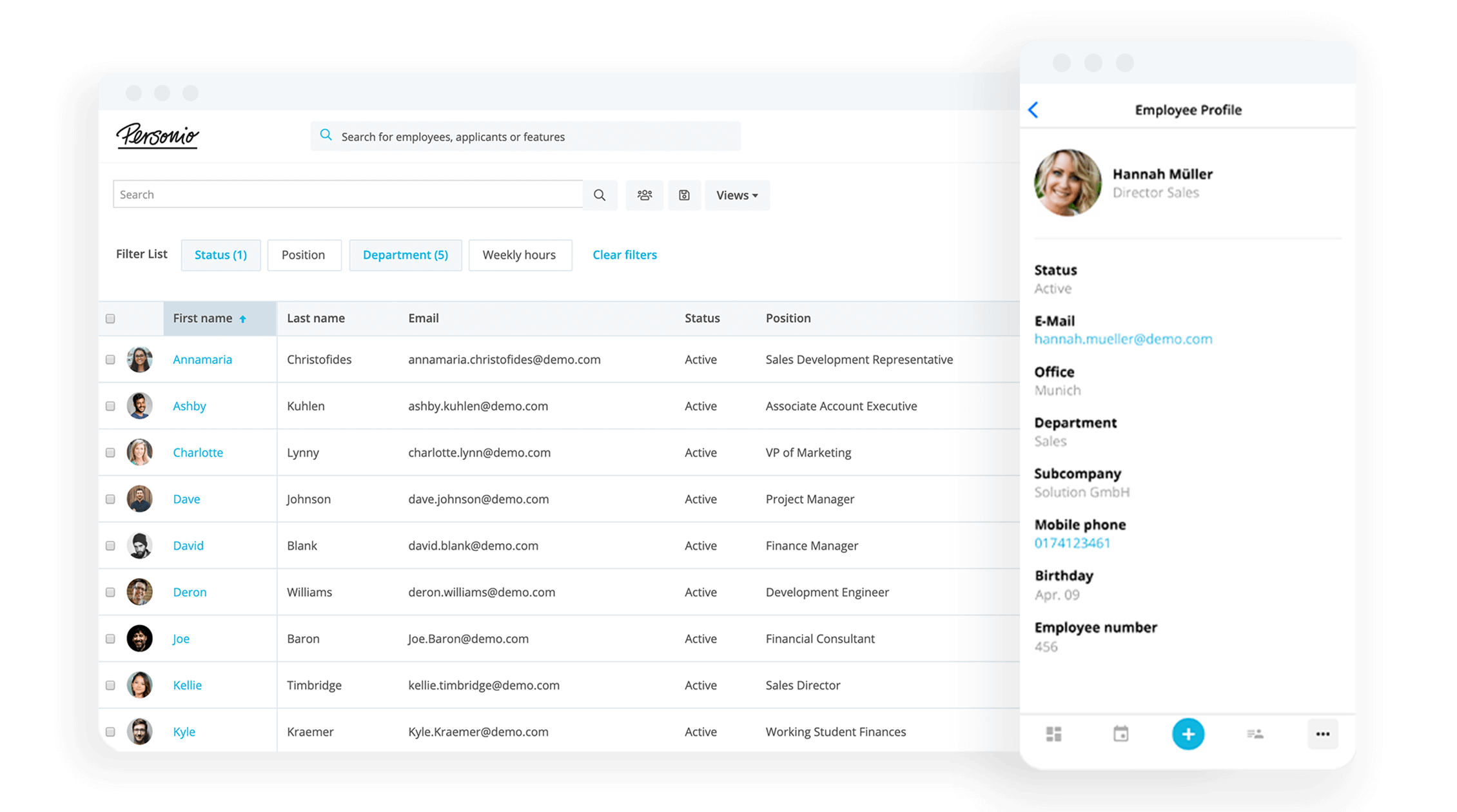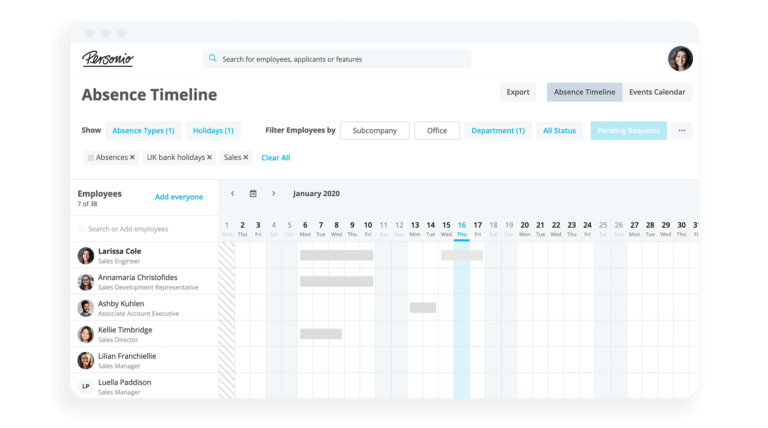
Easy-to-Use Absence Management
Get a detailed overview of all employee leave.
Simplify Your Absence TrackingHow Long is Maternity Leave in the UK?

Maternity leave and parental leave: Two key considerations that HR and organizations always need to have in mind. When it comes to absences, documentation, and the general process, there are so many questions at hand. In this article, we'll run through the basics, while showing you how to keep an overview of the entire process with ease.
All of your tasks and relevant reminders, in one place. Here’s how Personio helps.
What Is Maternity Leave?
Maternity leave is a type of employee leave taken during the birth of a child for workers legally classed as employees. It entails up to 52 weeks of time off, but it can be split up in different and varying ways.
How Long is Maternity Leave?
Maternity leave normally lasts up to one year. But, it is broken down into two parts:
Ordinary maternity leave (the first 26 weeks)
Additional maternity leave (the next 26 weeks)
For mothers, they are required to take four weeks’ leave after their baby is born (or four weeks if they work in a factory). Beyond that, though, the choice of when to take time off is up to them.
Employees typically start the maternity leave period up to 11 weeks before the expected date of childbirth. Or, the day after the birth when the child is early. If employees are off work for a pregnancy-related illness four weeks before, then their maternity leave will begin at that point in time.
Before we dive any deeper, though, let’s get acquainted with some familiar terms that will help us out…
Parental Leave Terminology: Summarized
– 52 weeks
– up to 39 weeks – see details below for pay amounts.
Statutory Adoption Pay and Leave
– similar, but for parents adopting a child
– up to 2 weeks’ leave (plus attending 2 antenatal appointments) – also see Shared Parental Leave
– similar to SML but split between parents. The rules are slightly different for KIT days
– essentially, the same as SMP but split between parents
– up to 10 for maternity / adoption leave. Up to 20 for Shared Parental Leave.
Is Parental Leave Only For Mothers?
Just as the definition of a parent has changed over time (same-sex partners can be parents, too), parental leave is not exclusively for mothers. Employees don’t have to have had the baby themselves, those who have had a child with a surrogate are entitled to parental leave, for instance.
Reduce Your Administrative Tasks

Check employee absences company-wide in just one click with Personio’s powerful dashboards.
See Staff Availability With EaseHow Much Parental Pay Are Employees Entitled to?
According to the UK Government, statutory maternity pay is only paid for up to 39 weeks. Here’s how it breaks down:
Timeframe | Amount |
|---|---|
First Six Weeks | 90% of average weekly earnings (before tax) |
Next 33 Weeks | £148.68 or 90% of their average weekly earnings (whichever is lower) |
Last 13 Weeks (Optional) | Unpaid or if taking ShPP they only earn the lower amount of 90% of their pay or £148.68 |
That said, it is possible for your company to choose to pay more than Statutory Maternity Pay. According to the Money Advice Service, "Some employers might offer occupational maternity pay, sometimes known as contractual maternity pay.”
Who Can Take Parental Leave And When?
The rules here are a bit complicated. In essence, ‘Shared Parental Leave’ (SPL) as it is called, allows parents to split the leave time between them.
They can also be entitled to receive Statutory Shared Parental Pay (ShPP). According to the gov.uk site, you:
Can share up to 50 weeks of leave and up to 37 weeks of pay.
Need to share the pay and leave in the first year after your child is born or placed with your family.
Can use SPL to take leave in blocks separated by periods of work, or take it all in one go.
You can also choose to be off work together or to stagger the leave and pay.
However, employees do need to meet eligibility criteria (which are different for birth parents and adoptive parents). More importantly, and especially for HR, they also need to give notice to their employers as well as meet ‘length of employment’ criteria.
Specifically, parents wanting to take SPL or ShPP must “have been employed continuously by the same employer for at least 26 weeks by the end of the 15th week before the due date.”
They can split SPL up into 3 separate blocks of leave, if they choose, and if they want to come back to work at a different date to what you originally agreed, that’s okay. But, this is only true if they give you at least eight weeks of notice. You can also ask for the birth certificate and details of their partner’s employer.
Have employees upload documents for HR to manage in Personio.
What Are The Rules Around Statutory Maternity Leave?
When applying for Statutory Maternity Leave (SML) employees need to tell their employers at least 15 weeks before their due date (or as soon as possible if they didn’t know they were pregnant). An employer can require an employee to provide notice of SML in writing, but you must reply within 28 days. They also need to tell you when they want to start their Statutory Maternity Leave and Statutory Maternity Pay.
Interestingly, the people who work for you only qualify for SML if they’re an employee, not a ‘worker’ and they provide the correct amount of notice, but they are always entitled to take SML: It doesn’t matter how long they’ve been working for you, the government allows them to take SML regardless.
Also, somewhat strangely, employees don’t necessarily have to provide proof of pregnancy if they’re asking for Statutory Maternity Leave. They do have to provide proof if they are applying for Statutory Maternity Pay.
Check out our breakdown on the three key types of employment status today.
Rules Surrounding Statutory Maternity Pay
For Statutory Maternity Pay (SMP)employees are also required to give at least 28 days’ notice, but they also have to earn, on average, at least £118 a week and must have worked for your continuously for at least 26 weeks before the day they have to inform you about their pregnancy (i.e. the 15th week before the expected week of childbirth).
When asking for SMP, they need to provide proof that they’re pregnant. This can be in the form of a letter from their doctor or midwife or an MATB1 certificate. Without proof of pregnancy, they cannot get SMP.
Once they have provided this you must respond within 28 days and tell them how much Statutory Maternity Pay they will receive and when it will start and stop.
However, employers can also decide that employees are not eligible for SMP. There’s a form called SMP1. It has to be provided within seven days of an employee’s request to get Statutory Maternity Pay and you will need to explain why employees are not eligible.
If they’re not eligible for SMP they might be able to get Maternity Allowance from the government instead. This is available to people who are employed but not eligible for SMP, are self-employed, or have recently stopped working.
Securely Store Your Documents

Keep up-to-date employee files with personal information, forms, and important documents stored together in one organised, data-compliant place.
Centralise Your Employee DataWhat Are Employees Rights While on Leave?
Be aware of employee rights while on leave:
Employees can work for 10 paid ‘Keeping in touch days’ (KIT), but only if you agree to this with them.
Don’t forget that they do continue to build up holiday entitlement and can take any holiday they’ve accrued (built-up) before or after the maternity/paternity/adoption/shared parental leave.
They have the right to ask you to consider flexible working. Employers don’t have to say yes.
Employees are also entitled to earn time off in lieu of bank holidays if they are normally entitled to take these as leave in addition to their standard annual leave.
They have the right to return if they take paternity leave, only 26 weeks of maternity/adoption/shared parental leave (if that’s taken between both parents), or 4 weeks or less of unpaid parental leave. If the employee takes more leave they’ll still have the right to their job or a similar job (with the same or better terms and conditions).
Employees have the same redundancy rights during all parental leave.
According to the Citizens Advice Bureau they are also entitled to pay reviews, a pension (this may change at 26 weeks), bonuses (depending on how their bonuses are normally calculated).
They have the right to paid time off for any antenatal appointments made on the advice of registered medical practitioners, midwives, or health visitors.
Other Employee Rights that Are Sometimes Ignored
Don’t forget about health and safety risks. Pregnant mothers should not be exposed to heavy lifting, standing or sitting for long periods without a break, working long hours, or being exposed to toxic substances.
It is also against the law to discriminate against an employee (or prospective employee) because of them being pregnant. This includes asking job candidates questions of a personal nature and ensuring that employees are not being subjected to offensive comments or behaviour.
ACAS also recommends that there is a place provided for a breastfeeding mother to sit (not a toilet).
They also have the right to protection against unfair treatment, discrimination, or dismissal.
Things Employees Must Not Do
Employees cannot work for more than 10 ‘keeping in touch’ days unless they want to lose some of their maternity benefits.
They can’t take time off for antenatal appointments until they’ve told you about the pregnancy.
How Do You Handle Parental Leave Proactively?
While having an employee off work to have or adopt a baby can be stressful for employers, it can also be an opportunity for employers to demonstrate their commitment to their employees. A caring, welcoming attitude towards staff goes a long way for your employer brand and workplace culture.
However, regardless of your company’s approach to parental leave – be sure that you keep track of all the relevant documents. You might find that HR software can be incredibly helpful for your organization, especially to ensure that the rules are followed, documented, and absences are visible!
Disclaimer
We would like to inform you that the contents of our website (including any legal contributions) are for non-binding informational purposes only and does not in any way constitute legal advice. The content of this information cannot and is not intended to replace individual and binding legal advice from e.g. a lawyer that addresses your specific situation. In this respect, all information provided is without guarantee of correctness, completeness and up-to-dateness.

